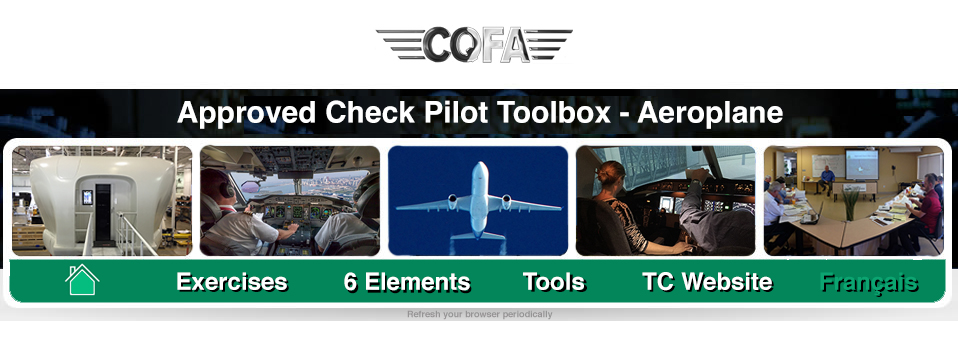7. Rejected take-off (RTO)
Aim
Determine the candidate’s ability to recognize an abnormal situation necessitating a rejected takeoff and to carry out an appropriate procedure in accordance with the AFM/POH and/or SOP’s.
Description
When performed in a simulator, the candidate will demonstrate a rejected take-off before reaching lift-off speed or if conducted in the aircraft, the candidate will verbally explain this manoeuvre during the briefing. . Where an operator has RVR 1200 or RVR 600 take off limits authority, the candidate will demonstrate one such rejected take off to the lowest limit as appropriate to his flight crew position.
For 704 and 705 PPC’s conducted in a simulator, the candidate will demonstrate a rejected take-off from a speed of not less than 90% of the calculated V1 or less if appropriate to the aeroplane type.
725 Schedule I
(h) Abnormal and Emergency Procedures
(i) ...
(ii) ...
(iii) at least two simulated engine failures, excluding failures on the runway followed by a rejected take-off, at any time during the check.
Performance Criteria
(06/2017 FTG p.24) Assess the candidate’s ability to:
- demonstrate adequate knowledge of the technique and procedure for accomplishing a rejected takeoff after powerplant/system(s) failure/warnings, including related safety factors;
- take into account, prior to beginning the takeoff, operational factors which could affect the manoeuvre, such as Takeoff Warning Inhibit Systems or other aeroplane characteristics, runway length, surface conditions, wind, obstructions that could affect takeoff performance and could adversely affect safety;
- align the aeroplane on the runway centreline;
- perform all required pre-takeoff checks as required by the appropriate checklist items;
- adjust the powerplant controls as recommended for the existing conditions;
- apply the controls correctly to maintain longitudinal alignment on the centreline of the runway;
- abort the takeoff if, in a single-engine aeroplane the powerplant failure occurs prior to becoming airborne, or in a multiengine aeroplane, the powerplant failure occurs at a point during the takeoff where the abort procedure can be initiated and the aeroplane can be safely stopped on the remaining runway/stopway. If a flight simulator is not used, the powerplant failure will be explained by the candidate prior to the flight;
- reduce the power smoothly and promptly, if appropriate to the aeroplane, when powerplant failure is recognized; and
- use spoilers, prop reverse, thrust reverse, wheel brakes, and other drag/braking devices, as appropriate, maintaining positive control in such a manner as to bring the aeroplane to a safe stop. Accomplishes the appropriate powerplant failure or other procedures and/or checklists as set forth in the POH or AFM or SOP.
Commenting a "1"
- Major deviation from runway centerline while decelerating.
- Did not deploy reverse thrust and/or spoilers.
- Excessive delay in recognizing RTO requirement resulting in lost runway distance.
- Used reverse until below AFM maximum speed.
- RTO initiated despite power loss ____ kts faster than V1.
- Runway excursion during RTO.
- As PNF, made no call, took no action during RTO.
Commenting a "2"
- Deviations from centerline during initial phase of deceleration, corrected before 80 kts.
- Slow to recognize RTO conditions, but remainder of RTO performed as per SOP.
- RTO performed satisfactorily, but based on wrong assumption. (Details...)
- RTO stopped on runway despite not having applied maximum reverse thrust.
- On RTO, spoilers extended out of SOP sequence, but stopping distance not adversely affected.
- PNF RTO calls not as per SOP.
